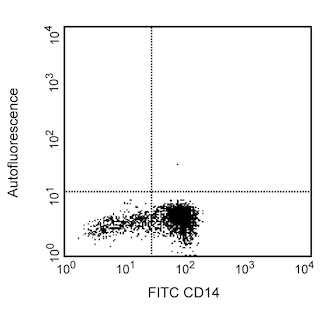Old Browser
Looks like you're visiting us from {countryName}.
Would you like to stay on the current country site or be switched to your country?
.png)
.png)
Regulatory Status Legend
Any use of products other than the permitted use without the express written authorization of Becton, Dickinson and Company is strictly prohibited.
Preparation And Storage
Product Notices
- Since applications vary, each investigator should titrate the reagent to obtain optimal results.
- Please refer to www.bdbiosciences.com/us/s/resources for technical protocols.
- For fluorochrome spectra and suitable instrument settings, please refer to our Multicolor Flow Cytometry web page at www.bdbiosciences.com/colors.
- Caution: Sodium azide yields highly toxic hydrazoic acid under acidic conditions. Dilute azide compounds in running water before discarding to avoid accumulation of potentially explosive deposits in plumbing.
The 14-4-4S monoclonal antibody specifically recognizes the I-E[k] MHC class II alloantigen. It crossreacts with cells from mice of the H-2[d], H-2[p], and H-2[r] haplotypes. Cells from mice of the H-2[b], H-2[f], H-2[g7], H-2[q], and H-2[s] haplotypes do not express I-E antigen. It has been reported that mAb 14-4-4S crossreacts with the rat MHC class II antigen RT1D.
This antibody is routinely tested by flow cytometric analysis. Other applications were tested at BD Biosciences Pharmingen during antibody development only or reported in the literature.

Development References (5)
-
Blankenhorn EP, Symington FW, Cramer DV. Biochemical characterization of Ia antigens encoded by the RT1.B and RT1.D loci in the rat MHC. Immunogenetics. 1983; 17(5):475-484. (Clone-specific). View Reference
-
Hattori M, Buse JB, Jackson RA, et al. The NOD mouse: recessive diabetogenic gene in the major histocompatibility complex. Science. 1986; 231(4739):733-735. (Biology). View Reference
-
Klein J. Mutations in H-2E loci. In: Klein J. Natural History of the Major Histocompatibility Complex. New York: John Wiley & Sons; 1986:216-218.
-
Neiss U, Reske K. Non-coordinate synthesis of MHC class II proteins and invariant chains by epidermal Langerhans cells derived from short-term in vitro culture. Int Immunol. 1994; 6(1):61-71. (Clone-specific). View Reference
-
Ozato K, Mayer N, Sachs DH. Hybridoma cell lines secreting monoclonal antibodies to mouse H-2 and Ia antigens. J Immunol. 1980; 124(2):533-540. (Immunogen). View Reference
Please refer to Support Documents for Quality Certificates
Global - Refer to manufacturer's instructions for use and related User Manuals and Technical data sheets before using this products as described
Comparisons, where applicable, are made against older BD Technology, manual methods or are general performance claims. Comparisons are not made against non-BD technologies, unless otherwise noted.
For Research Use Only. Not for use in diagnostic or therapeutic procedures.
Refer to manufacturer's instructions for use and related User Manuals and Technical Data Sheets before using this product as described.
Comparisons, where applicable, are made against older BD technology, manual methods or are general performance claims. Comparisons are not made against non-BD technologies, unless otherwise noted.
Report a Site Issue
This form is intended to help us improve our website experience. For other support, please visit our Contact Us page.
